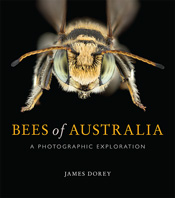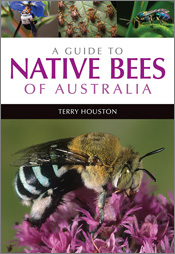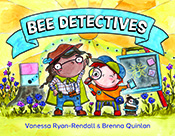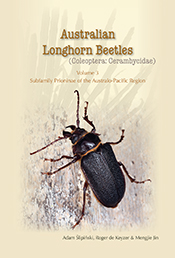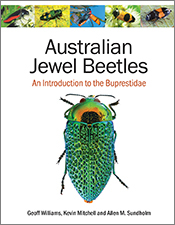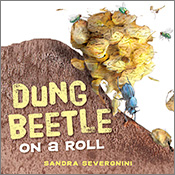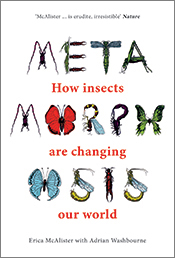Bees of Australia
A Photographic Exploration
By: James DoreyDiscover the beauty and diversity of Australia's native bees.
Bees are the darlings of the insect world. It is a joy to see these insects hard at work, peacefully buzzing from flower to flower. Many people recognise the worth of bees, as well as that they face multiple threats. But very few know about the diversity and importance of our native bee species. There are an estimated 2000 to 3000 bee species in Australia, yet we know very little about the vast majority of these and there are many that are yet to be described. + Full description
Bees of Australia introduces some of our incredible native bees, many of which, if you look closely, can be found in your own garden. Open this book wherever you like or read it from cover to cover. The combination of photography and contributions from some of Australia’s leading bee researchers allows anyone to become enthralled by our native bees. Don’t be surprised if you find yourself looking closer at every flower that you pass in search of our wonderful native bees.
- Short descriptionReviews
"A truly eye-opening piece of work, and one that I have found so inspiring as to kickstart a new section of Conjour’s reporting... We could give no greater testament to the impact of this book.
Save, perhaps, the knowledge that I have been trying to work out how to build an insect home ever since I finished reading it."
Joel Howland, Conjour (Conservation Journal), 12 November 2018
"I recommend this book to each and every beekeeper, lover of insects, and connoisseur of great photography."
Robert McDonald, Australian Bee Journal 99(9), September 2018
"What a joy for one who is an amateur native bee enthusiast to review this book... it has certainly succeeded in James' goal of introducing the subject of native bees in a manner that can be enjoyed at many levels and the stunning photographs alone make the book worthwhile."
Linda Rogan, Victorian Entomologist 48(5), October 2018
"This book introduces the reader to the amazing diversity of native bees through striking photos set again a black background... This book would make a great gift for a bee-lover!"
Entomological Society of Queensland News Bulletin 46(6), September 2018
"Currently, there are over 1600 named species out of an estimated two to three thousand. A jaw-dropping statistic in itself, but just as impressive is Dorey’s spectacular macro photography that gets you right up close to these amazingly beautiful creatures. This state-by-state guide is a photographic page-turner accompanied by snappy and easy to digest text covering each highlighted species."
Readings Summer Reading Guide 2018-19
"A visual treat awaits those who open this recently published book by experienced nature photographer James Dorey... this beautiful book is sure to inspire people to go out and peer carefully into gardens, parks and habitats, looking for these fascinating pollinators. It may even encourage some to become researchers – a rich field when there is so very little known about the behaviour of most native bee species."
Jenny Thynne, Wildlife Australia Magazine, Summer 2018
"A unique aspect of this book is that you can open it at any page and enjoy it as much as if you began at page one. Each species is its own entity and has its own story and yet the cumulative bee stories demonstrate the complexity and unknown state of Australian bees. I highly recommend this book as a visual exploration of our native Australian bees."
Ken Walker, The Victorian Naturalist 136(1), February 2019
"Dorey puts into words his infectious enthusiasm for the subject that is so obvious from the images."
Laurence Packer, The Quarterly Review of Biology 94, September 2019
Details
Paperback | October 2018 | $ 49.99ISBN: 9781486308491 | 224 pages | 255 x 225 mm
Publisher: CSIRO Publishing
Colour photographs, Illustrations
ePDF | October 2018
ISBN: 9781486308507
Publisher: CSIRO Publishing
Available from eRetailers
Features
- Discover the extraordinary diversity of Australia’s native bees
- Each page features stunning macro photographs of bees from around Australia
- Includes fascinating contributions from Australia's leading bee researchers on topics such as pollination, social behaviour, threats, and how to find bees and attract them to your garden
Contents
Foreword - by Tim New
Acknowledgements
Introduction
1. New South Wales
Amegilla (Asaropoda) bombiformis
Megachile ustulata
Amegilla (Zonamegilla) asserta
Undescribed Leioproctus (Exleycolletes) sp.
Lasioglossum (Parasphecodes) lithuscum
Hylaeus (Macrohylaeus) alcyoneus
Lasioglossum (Chilalictus) lanarium
Leioproctus (Exleycolletes) cristatus
Exoneura sp.
Thyreus nitidulus
Why are bees important? - by James Dorey
2. Queensland
Austroplebeia australis
Palaeorhiza (Cnemidorhiza) disrupta
Megachile abdominale
Braunsapis sp.
Hylaeus (Euprosopoides) ruficeps
Euryglossina (Microdontura) mellea
Megachile apicata
Tetragonula carbonaria
Hylaeus (Gnathoprosopis) albonitens
Megachile aurifrons
Australian native bees as crop pollinators - by Tobias J. Smith
3. Victoria
Homalictus punctatus
Leioproctus (Leioproctus) plumosus
Hylaeus (Gnathoprosopoides) philoleucus
Lasioglossum (Chilalictus) veronicae
Lasioglossum (Chilalictus) sp.
Amphylaeus (Amphylaeus) morosus
Pachyprosopis (Pachyprosopis) haematostoma
Nomia (Paulynomia) aurantifer
Euryglossina (Euryglossina) hypochroma
Apis mellifera
Threats to our bees - by Matthew Elmer
4. Western Australia
Amegilla (Notomegilla) chlorocyanea
Hylaeus (Euprosopis) husela
Homalictus dampieri
Xylocopa (Koptortosoma) parvula
Callohesma flavopicta
Austroplebeia essingtoni
Exoneura sp.
Hylaeus (Euprosopoides) obtusatus
Thyreus waroonensis
Social behaviour of bees - by Tim Heard
5. South Australia
Brachyhesma houston
Homalictus urbanus
New Exoneura sp.
Hylaeus (Euprosopis) honestus
Lasioglossum (Callalictus) callomelittinum
Euryglossa adelaidae
Pachyprosopis (Pachyprosopula) kellyi
Brachyhesma sp.
Lipotriches (Austronomia) australica
Exoneura sp.
How to find native bees - by James Dorey
6. Tasmania
Heterohesma clypeata
Hylaeus (Prosopisteron) perhumilis
Paracolletes (Paracolletes) crassipes
Leioproctus (Leioproctus) amabilis
Exoneura (Inquilina) sp.
Megachile (Eutricharaea) maculariformis
Hylaeus (Prosopisteron) quadratus
Bombus terrestris
How to attract native bees to your garden - by Megan Halcroft of Bees Business
7. Northern Territory
Undescribed Amegilla (Asaropoda) sp.
Brachyhesma perlutea
Braunsapis sp.
Hylaeus (Rhodohylaeus) maiellus
Hyleaus (Euprosopis) elegans
Lasioglossum (Chilalictus) ochroma
Lipotriches (Austronomia) sp.
Meroglossa torrida
Xanthesma (Xanthesma) flava
8. Museums
Ctenocolletes smaragdinus
Megachile (Schizomegachile) monstrosa
Xylocopa (Koptortosoma) aruana
Palaeorhiza varicolor
Quasihesma gigantica
Lasioglossum (Chilalictus) hemichalceum
Amegilla (Asaropoda) dawsoni
Xylocopa (Lestis) aeratus
Hyleoides zonalis
The importance of museums - by Michael Batley
Glossary
Appendix of species by family
Further reading
Index
Authors
James Dorey is undertaking a PhD on the evolution, taxonomy and ecology of Australian native bees at Flinders University, Adelaide. His stunning macro photographs have been published in books and magazines, and have been honoured in national and international photography competitions. He is amazed at the hidden diversity of bees.

